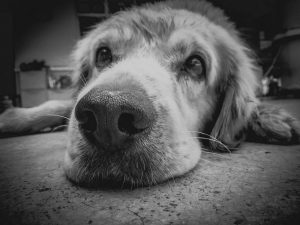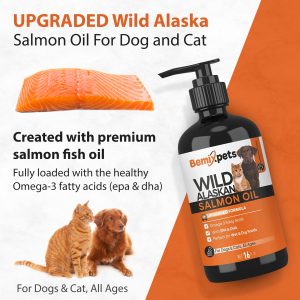Contents
What Causes Allergic Reactions?
We humans can be allergic to all sorts of things. Things like mold, peanuts, dairy, pollen, pets, and more. Our allergic reactions can manifest in a myriad of symptoms including things like swelling of the face, hands, throat, or other areas, rashes, sneezing, watery eyes, hives, and more. But what is it in that bit of pollen, peanut, or pet dander that makes you react?
Well, it’s a protein in most cases. If you have an allergic reaction to something it is because your body doesn’t like one, or more, of the proteins in the substance that you came into contact with. For some reason, your body thinks that this protein is a foreign invader that must be stopped. So, the body mounts an attack against the offending protein. The symptoms are the result of your body’s assault on the enemy protein.
Protein is the main offender when it comes to dogs. Dogs secrete and create a couple of proteins that may be to blame for your allergy. These proteins are especially concentrated in dog urine and saliva, to a lesser degree, it is found in dog dander. So, if you know that you are allergic to dogs, definitely do not let them lick you!
What People Often Think Hypoallergenic Means
When most people think of hypoallergenic they assume that it means that the hypoallergenic item will not cause an allergic reaction… This, sadly, is untrue. Hypoallergenic actually means that the item is less likely to cause an allergic reaction.
For example, there may be a hypoallergenic makeup or fabric. Terming them hypoallergenic simply means that they contain ingredients that are less likely to cause an allergic reaction. However, in some people, they may still cause a reaction.
You see each individual who suffers from allergies has a different level at which their body will react. Some people have a mild allergy so when they use the hypoallergenic makeup they do not react. Other people are severely allergic and will have a severe reaction to the same hypoallergenic makeup. Allergies are very individual in the reactions as well as the severity of the allergy.
What Hypoallergenic Can Mean In Dogs
So, what does it mean if you see a dog that claims to be hypoallergenic? Well, just like with the fabric or makeup from the example above, it means that this particular dog or breed is less likely to cause an allergic reaction. For some people, this individual dog or breed may not cause a reaction, but it still could in other people.
When we think of hypoallergenic dogs we typically think of dogs that shed very little, poodles and Bichon Frise, as examples. This is one facet that can cause a dog to be hypoallergenic. Another is the size of the dog. A very small dog will have less dander than a very big dog, again possibly making the small dog hypoallergenic. A hairless dog may also be considered hypoallergenic. Then even within a breed each dog is an individual and may produce more or less of the offending proteins. A dog that produces less could be considered hypoallergenic when compared with the others.
One other important facet is how a particular dog is cared for. If the particular dog is brushed daily it will have less dander than the same breed that is not brushed daily. Thus, making a dog that is more hypoallergenic than the dog that is not brushed daily.
However, most people just think of hypoallergenic in reference to dogs that shed less. As an interesting aside, dogs that are fed a species-appropriate raw diet also shed less. So, if you have an allergy to dogs but want to own a dog it is a wise choice to feed your dog a raw diet.
Hypoallergenic Pure Breed Dogs
Many pure breeds are considered hypoallergenic in the minimal shedding sense. Here are a few of them:
- Afghan Hounds
- American Hairless Terrier
- Bedlington Terrier
- Bichon Fise
- Chinese Crested
- Coton de Tulear
- Schnauzer (all sizes)
- Irish Water Spaniel
- Kerry Blue Terrier
- Maltese
- Peruvian Inca Orchid (hairless)
- Poodles (all sizes)
- Portuguese Water Dogs
- Soft Coated Wheaten Terrier
- Spanish Water Dog
- Xoloitzcuintli
Hypoallergenic Designer Breeds
Many mixed breeds are also considered to be hypoallergenic. Generally, these are going to be any mixed dog that has at least one hypoallergenic parent. For instance, a Goldendoodle is half Golden Retriever and half Poodle. The Goldendoodle gets its hypoallergenic qualities from the Poodle side. At least, in theory, the Goldendoodle puppies will be hypoallergenic. But, remember each dog is an individual and some will be more hypoallergenic than others.
Now there is a little something that you should know when looking for a hypoallergenic designer breed. One of the dog’s parents must be a purebred hypoallergenic breed or the resulting puppies will not be hypoallergenic. Even if you mix a Goldendoodle with a Goldendoodle their offspring are not hypoallergenic.
Now if you mix a Goldendoodle with a Poodle then the puppies will be hypoallergenic because they are now 75% Poodle. So, the more Poodle there is in the parentage the more hypoallergenic the puppies are likely to be.
While designer breeds can seem like a nice idea be sure that you are very informed and find an amazing breeder. Know the genetic issues of each breed involved and if those issues would exacerbate one another. Be aware that many designer dog breeders are in it to make money and they are not necessarily interested in creating dogs that are actually hypoallergenic or that will have good health or temperament.
Testing Your Allergy To A Dog
If you have an allergy to dogs but would like to own one, it is a good idea to go about testing your allergy. Try hanging around with different breeds of dog, starting with breeds that are known to be hypoallergenic. If all goes well with these breeds then you might want to try small breeds to see if they affect you. If things go okay with the small breeds try the small breeds during shedding season.
Be aware that just because one dog of a specific breed does not bother you that does not mean that all dogs in that breed will not bother you. Each dog is unique and creates different levels of proteins that cause allergies. Also, each individual dog has a different level at which they shed fur and dander.
Once you find a breed that seems to consistently not cause an allergic reaction it is time to find an excellent breeder! Remember it is still important to find a reputable breeder. Once you find a reputable breeder for your chosen breed ask the breeder if you can come and hang out with some of their dogs. Be sure to make them aware of your allergy. If the parents of the puppies dog do not aggravate your allergy, odds are good that their puppies won’t either.
Simple Ways To Reduce Allergies
If you have a dog or intend to get one, there are many ways that you can reduce the dander in your home and thus reduce the likelihood of you having an allergic reaction.
- Brush your dog outside on a daily basis, this helps to reduce dander in the house
- Vacuum your home daily, especially areas that your dog frequents
- Do not allow your dog to lick you, remember the protein that causes reactions is concentrated in saliva
- Don’t allow your dog on the furniture or to sleep in bed with you
- Wash your hands after interacting with your dog. Do not touch your eyes or mouth before you wash your hands
- Have a few rooms that your dog is not allowed to enter. This will give you a place to escape if you feel a reaction coming on
- Use a HEPA air filter in your home to help remove dander
- Replace and carpet with smooth floors that will not trap the dander
If you really want to reduce your likelihood of an allergic reaction to your dog you may want to look into diet. The diet of you and your dog! As I said above a raw diet will help to reduce shedding in all breeds of dog. So, feeding a dog a raw diet will help to make it more hypoallergenic.
Additionally, a diet for humans that helps to lower inflammation can help to reduce the likelihood and severity of allergic reactions. Diets to explore could be keto or paleo diets. Indeed there may even be one or two foods that you are eating that are keeping your body inflamed and just removing these foods may reduce your allergy.
Conclusion
Hypoallergenic means that the thing termed hypoallergenic is less likely to cause an allergic reaction, not that it will not cause a reaction at all. The main thing that causes allergic reactions is proteins. With dog allergies, two proteins cause allergic reactions these proteins are concentrated in the urine, saliva, and, to a less degree, dander.
When a dog is called hypoallergenic this usually means that the dog sheds less. Less shedding equals less dander. However, each individual dog is different. Some will create more of the protein than others. If you have an allergy to dogs, but still want to own a dog, then it is best to look for an individual dog that does not exacerbate your allergy.
There are many ways that you can reduce your likelihood of having an allergic reaction if you own a dog. Things like having dog-free rooms, washing your hands after touching your dog, and not allowing your dog to lick you are all important steps to take. It is also worthwhile to learn about raw feeding and to feed your dog a species-appropriate raw diet. It may also be helpful to inspect your own diet and change to a less inflammatory diet.






Leave a Reply
You must be logged in to post a comment.